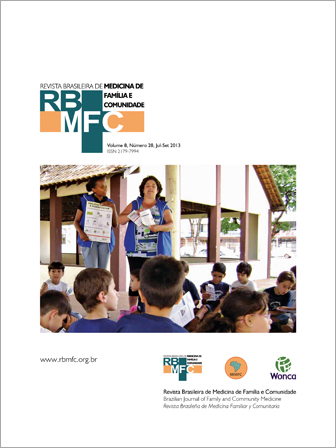Somatoform symptoms in family medicine: a descriptive study of incidence and outcome in a family health center in Portugal
DOI:
https://doi.org/10.5712/rbmfc8(28)652Keywords:
Signs and Symptoms, Somatoform Disorders, Family PracticeAbstract
Objective: This study aimed to estimate the proportion of patients with physical complaints, not attributable to organic causes, presented to family physicians working in an urban Portuguese primary care center and to evaluate the outcome of these clinical cases after 6 months of observation. Methods: For a week, eight family physicians were asked to identify consulting patients whose physical complaints did not seem to have organic causes. These patients were re-evaluated six months later to determine the outcome of their symptoms. Results: The eight physicians conducted 864 appointments during the study period and identified 73 patients (8%) with physical complaints for which no organic explanation was found. These patients were more likely to suffer from depression, anxiety, headache, and irritable bowel syndrome. After six months of follow-up, an organic cause was identified in only three of these patients, while 21 out of 73 patients (33%) had persistent unexplained symptoms. Conclusions: Patients with unexplained physical symptoms are frequently encountered in family practice. Most symptons resolve completely and clinicians have a small probability of missing a significant organic diagnosis in these patients.
Downloads
Metrics
References
Melville DI. Descriptive clinical research and medically unexplained symptoms. J Psychosom Res. 1987; 31(3):359. http://dx.doi.org/10.1016/0022-3999(87)90056-0
Peveler R, Kilkenny L, Kinmonth AL. Medically unexplained physical symptoms in primary care: a comparison self-report screening questionnaires and clinical opinion. J Psychosom Res. 1997; 42(3):245-52. http://dx.doi.org/10.1016/S0022-3999(96)00292-9
Scicchitano J, Lovell P, Pearce R, Marley J, Pilowsky I. Illness behavior and somatization in general practice. J Psychosom Res. 1996; 41:247-254. http://dx.doi.org/10.1016/0022-3999(96)00034-7
Mumford DB, Devereux TA, Maddy PJ, Johnston JV. Factors leading to the reporting of ‘functional’ somatic symptoms by general practice attenders. Br J Gen Pract. 1991; 41: 454-458.
Fabião C, Barbosa A, Flemming M, Silva C. Rastreio da Perturbação de Somatização. Nos Cuidados Primários de Saúde. Resultados de um Estudo Piloto. Acta Med Port. 2008; 21:319-28.
Fink P, Sorensen L, Engeberg M, Holm M, Munk-Jorgensen P. Somatization in Primary Care. Prevalence, Health Care Utilization and General Practitioner Recognition. Psychosomatics. 1999; 40:330-338. http://dx.doi.org/10.1016/S0033-3182(99)71228-4
Kroenke K, Mangelsdorff AD. Common symptoms in ambulatory care: incidence, evaluation, therapy, and outcome. Am J Med. 1989; 86(3):262-6. http://dx.doi.org/10.1016/0002-9343(89)90293-3
Li CT, Chou YH, Yang KC, Yang CH, Lee YC, Su TP. Medically Unexplained Symptoms and Somatoform Disorders: Diagnostic Challanges to Psychatrists. J Chin Med Assoc. 2009; 72(5):251-6. http://dx.doi.org/10.1016/S1726-4901(09)70065-6
Reid S, Wessely S, Crayford T, Hotopf M. Medically unexplained symptoms in frequent attenders of secondary health care: retrospective cohort study. BMJ. 2001; 322:1-4. http://dx.doi.org/10.1136/bmj.322.7289.767
Smith R C, Dwamena FC. Classification and Diagnosis of Patients with Medically Unexplained Symptoms. J Gen Intern Med. 2007; 22:685-691. http://dx.doi.org/10.1007/s11606-006-0067-2
Jackson JL, Passamonti M. The Outcomes Among Patients Presenting in Primary Care with a Physical Symptom at 5 Years. J Gen Intern Med. 2005; 20:1032-7. http://dx.doi.org/10.1111/j.1525-1497.2005.0241.x
Jackson JL, Kroenke K. Managing Somatization. Medically Unexplained Should Not Mean Medically Ignored. J Gen Intern Med. 2006; 21(7):797-9. http://dx.doi.org/10.1111/j.1525-1497.2006.00514.x
Waal MWM, Arnold IA, Eekhof JAH, Assendelft WJJ, Van Hemert AM. Follow-up study on health care use of patients with somatoform, anxiety and depressive disorders in primary care. BMC Family Pract. 2008, 9:5. http://dx.doi.org/10.1186/1471-2296-9-5
Lynch DS, McGray AV, Nagel RW, Wahl E. The Patient-Physician Relationship and Medical Utilisation. Prim Care Companion J Clin Psychiatry. 2007; 9:266-70. http://dx.doi.org/10.4088/PCC.v09n0403
Pais-Ribeiro J. Questionário de manifestações físicas de mal-estar. Psiquiatr Clin. 2003; 24(1),65-76.
Khan AA, Khan A, Harezlak J, Tu W, Kroenke K. Somatic Symptoms in Primary Care: Etiology and Outcome. Psychosomatics. 2003; 44:171-8. http://dx.doi.org/10.1176/appi.psy.44.6.471
Morriss R, Gask L, Dowrick C, Dunn G, Peters S, Ring A, et al. Randomized trial of reattribution on psychosocial talk between doctors and patients with medically unexplained symptoms. Psychol Med. 2010; 40(02):325-333. http://dx.doi.org/10.1017/S0033291709990353
Feder A, Olfson M, Gameroff M, Fuentes M, Shea S, Lantigua RA, et al. Medically Unexplained Symptoms in an Urban General Medicine Practice. Psychosomatics. 2001; 42:261-8. http://dx.doi.org/10.1176/appi.psy.42.3.261
Muller JE, Wentzel I, Nel DG, Stein DJ. Depression and anxiety in multisomatoform disorder: Prevalence and clinical predictors in primary care. S Afr Med J. 2008; 98(6):473-6.
Gusmão R. Depressão: detecção, diagnóstico e tratamento. Estudo de prevalência e despiste das perturbações depressivas nos Cuidados de Saúde Primários. [Tese]. Lisboa: Universidade Nova de Lisboa; 2005.
Cortez-Dias N, Martins S, Belo A, Fiuza M. Prevalência e Padrões de Tratamento da Hipertensão Arterial nos Cuidados de Saúde Primários em Portugal. Resultados do Estudo VALSIM. Rev Port Cardiol. 2009; 28(5):499-523.
Falcão IM, Pinto C, Santos J, Fernandes ML, Ramalho L, Paixão E, et al. Estudo da Prevalência da diabetes e das suas complicações numa coorte de diabéticos portugueses: um estudo na Rede Médicos- Sentinela. Rev Port Clin Geral. 2008; 24:679-92.
Stone J, Smyth R, Carson A, Lewis S, Prescott R, Warlow C, et al. Systematic review of misdiagnosis of conversion symptoms and “hysteria”. BMJ. 2005. http://dx.doi.org/10.1136/bmj.38628.466898.55
Sá BA, Jordão JG. Estudo europeu sobre referenciação em cuidados primários. II - Dados de seguimento e informação de retorno. Rev Port Clín Geral. 1993;10:238-44.
Janeiro, M. Acesso aos Cuidados de Saúde Secundários numa extensão do Centro de Saúde de Serpa: 10 anos depois. Rev Port Clin Geral. 2001; 17:193-207.
Ponte CMF, Moura BG, Cerejo AC, Braga R, Marques I, Teixeira A, et al. Referenciação aos cuidados de saúde secundários. Rev Port Clin Geral. 2006; 22:555-68.
Downloads
Published
How to Cite
Issue
Section
License
By submitting a manuscript to the RBMFC, authors retain ownership of the copyright in the article, and authorize RBMFC to publish that manuscript under the Creative Commons Attribution 4.0 license and identify itself as the vehicle of its original publication.















